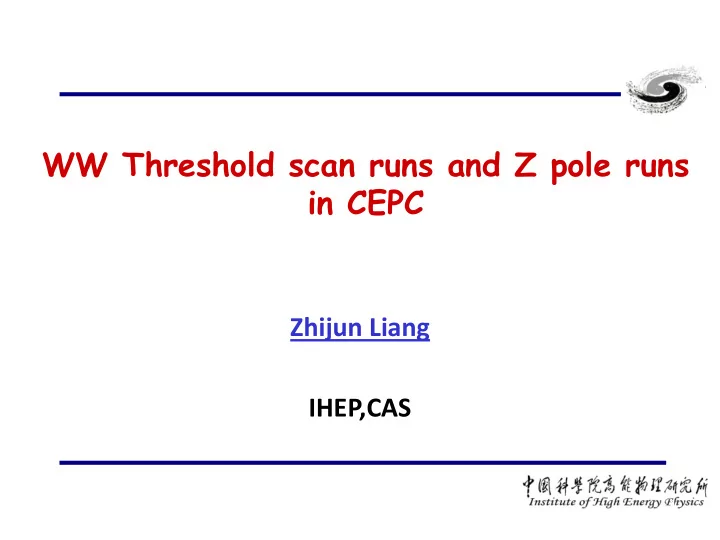

WW Threshold scan runs and Z pole runs in CEPC Zhijun Liang IHEP,CAS 1
Introduction • Some discussion about CEPC Z pole running . – http://indico.ihep.ac.cn/event/7709/ – Two possibility: • L=1.6 X 10 35 cm -2 s -1 , solenoid field = 3T • L=3.2 X 1035 cm -2 s -1 , solenoid field = 2T • Two year running proposed by accelerator team • WW threshold scan – Proposal from accelerator team – One year running, Total luminosity 3.2 ab -1 2
WW threshold scan Vs luminosity • WW threshold scan need to scan 3~5 mass points – Especially need to cover 158.5GeV, 161.2GeV, 162.4 GeV In CEPC Pre-CDR, we assume 0.5ab -1 for W threshold scan • – W width measurement is totally limited by statistics – W mass measurement suffers a bit from statistics • Assume we run one year WW threshold to collect 3.2 ab -1 data. – W width measurement is still limited by statistics, but much better than pre-CDR • If running for two years with 6.4 fb -1 – W width measurement is not limited by statistics any more Observable Systematics L=0.5 ab -1 L=3.2 ab -1 L=6.4 ab -1 Major (3 points scan, (3 points scan, (3 points scan, uncertainty 0.16 ab -1 per 1 ab -1 per run) 2 ab -1 per run) run) M w 2 MeV 2 MeV 0.8 MeV 0.6 MeV E beam cali. ΔE < 1 MeV G W 2 MeV 6 MeV 2.4 MeV 1.7 MeV Statistics 3
The parameters of CEPC Higgs W Z Number of IPs 2 Energy (GeV) 120 80 45.5 Circumference (km) 100 SR loss/turn (GeV) 1.73 0.34 0.036 Half crossing angle (mrad) 16.5 Piwinski angle 2.58 7.74 23.8 3T à 2T N e /bunch (10 10 ) 15 15 8.0 12000 Bunch number (bunch spacing) 242 (0.68us) 1220 (0.27us) (25ns+10%gap) Beam current (mA) 17.4 87.9 461 SR power /beam (MW) 30 30 16.5 0.2/0.00 Bending radius (km) 10.6 1 Momentum compaction (10 -5 ) 1.11 0.17/0.0015 b IP x/y (m) 0.36/0.0015 0.36/0.0015 0.2/0.0015 Emittance x/y (nm) 1.21/0.0031 0.54/0.0016 0.17/0.004 Transverse s IP (um) 20.9/0.068 13.9/0.049 5.9/0.078 x x / x y /IP 0.031/0.109 0.013/0.12 0.0041/0.056 V RF (GV) 2.17 0.47 0.1 650 (216816) f RF (MHz) (harmonic) Nature bunch length s z (mm) 2.72 2.98 2.42 Bunch length s z (mm) 3.26 6.53 8.5 HOM power/cavity (kw) 0.54 (2cell) 0.87(2cell) 1.94(2cell) Energy spread (%) 0.1 0.066 0.038 Energy acceptance requirement (%) 1.35 Energy acceptance by RF (%) 2.06 1.47 1.7 Photon number due to beamstrahlung 0.29 0.44 0.55 Lifetime _simulation (min) 100 32 4 Lifetime (hour) 0.67 (40 min) 2 F (hour glass) 0.89 0.94 0.99 L max /IP (10 34 cm -2 s -1 ) 2.93 11.5 16.6
Z pole electroweak physics Vs lumiosity • Assuming Z pole runs last for 180 days, Z cross section 60 nb L=1e 34 , about 10 10 Z • Observable Systematics L=1e 34 3T, L=1.6e 35 L=3.2e 35 Key (stat unc.) (stat unc.) (stat unc.) M z. G Z 0.5 MeV 0.2MeV 0.05 MeV 0.035 MeV E beam cali. ΔE < 500keV R l = G h / G l 0.01% 0.01% 0.0025% 0.0018% Statistics R b 0.05% 0.04% 0.01% 0.007% Statistics + small Rin A LR NA NA NA NA Beam polarization A FB lept. 0.1% 0.08% 0.02% 0.014% Forward acceptance Ø From 1e 34 to 1.6e 35 , large improvement in stat. uncertainty Ø From 1.6e 35 to 3.2 e 35 , improvement is not big Ø From 3T to 2T, Momentum resolution degraded to 50%, higher BkG. (no major impact ) Ø Key issue for Z pole physics, beam momentum systematics need to be smaller than 500keV Ø Beam polarization is needed for beam momentum measurement and ALR 5
backup 6
Cross section Vs W mass or W width • df 7
W mass stat uncertainty single energy point (500 fb -1 ) • df From Peixun and Gang 8
W width stat uncertainty single energy point (500 fb -1 ) • df From Peixun and Gang width 9
Start from detector solenoid 3.0T From Chenghui β y * Vs. coupling @ Z Limitation of the luminosity improvement by reducing the β y *
Start from detector solenoid 3.0T Coupling=1.7% + 0.3~0.5% From Chenghui Large beam size & serious bunch lengthening Coupling Vs. Luminosity @ Z For the 2Cell cavity operation, if the coupling lose control L » L 0 /2 ~ L 0 /4
Recommend
More recommend